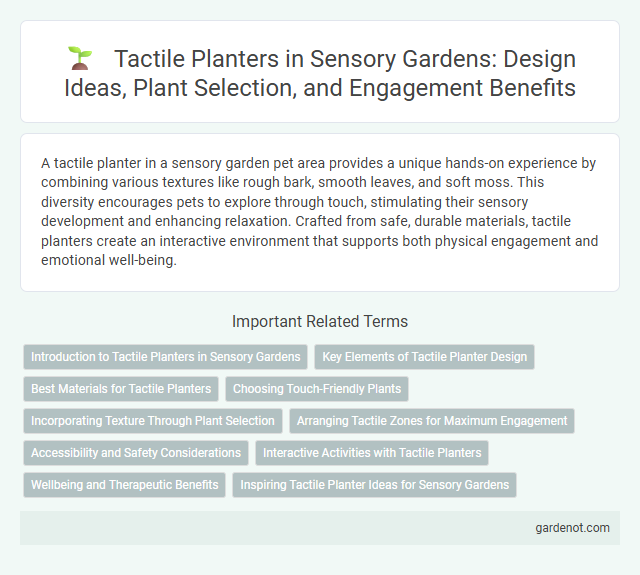A tactile planter in a sensory garden pet area provides a unique hands-on experience by combining various textures like rough bark, smooth leaves, and soft moss. This diversity encourages pets to explore through touch, stimulating their sensory development and enhancing relaxation. Crafted from safe, durable materials, tactile planters create an interactive environment that supports both physical engagement and emotional well-being.
Introduction to Tactile Planters in Sensory Gardens
Tactile planters in sensory gardens offer a unique opportunity for direct touch and interaction with various plant textures, enhancing sensory engagement. These planters are designed to be accessible at different heights to accommodate all users, including children and individuals with mobility challenges. Incorporating materials such as rough bark, soft leaves, and spiky succulents stimulates tactile exploration, supporting cognitive development and sensory integration.
Key Elements of Tactile Planter Design
Key elements of tactile planter design include varied textures, such as rough bark, smooth stones, and soft moss, to stimulate touch and enhance sensory experiences. The planter should be accessible at comfortable heights to accommodate all users, including children and individuals with mobility challenges. Durable, weather-resistant materials ensure longevity and maintain tactile quality in outdoor sensory gardens.
Best Materials for Tactile Planters
Best materials for tactile planters include natural wood, which offers a warm, organic texture and durability, and smooth ceramic that provides a cool, polished surface ideal for sensory exploration. Recycled plastic is also popular due to its weather resistance and ability to be molded into various shapes and textures that stimulate touch. Using these materials enhances the sensory experience while ensuring long-lasting performance in outdoor garden settings.
Choosing Touch-Friendly Plants
Selecting touch-friendly plants for a tactile planter involves prioritizing species with varied textures and safe, non-irritating surfaces. Popular choices include lamb's ear with its soft, velvety leaves, succulents that offer a smooth, fleshy feel, and ornamental grasses providing fine, wispy textures. Incorporating these diverse tactile experiences enhances sensory engagement and accessibility in the garden environment.
Incorporating Texture Through Plant Selection
Incorporating a tactile planter into a sensory garden enhances visitor engagement by focusing on diverse plant textures such as fuzzy lamb's ear, smooth snake plants, and rough succulents. Selecting plants with varying tactile qualities like soft moss, spiky grasses, and ridged aloe vera encourages hands-on exploration and sensory stimulation. These textural contrasts create a rich, interactive environment that supports sensory development and therapeutic experiences.
Arranging Tactile Zones for Maximum Engagement
Arranging tactile zones within a sensory garden enhances user interaction by incorporating a variety of textures such as rough bark, smooth stones, and soft moss, strategically placed at different heights and reach levels. Grouping plants with contrasting tactile qualities, like fuzzy lamb's ear alongside spiky ornamental grasses, encourages detailed exploration and stimulates sensory awareness. Clear pathways and accessible planter designs facilitate engagement for all users, including children and those with limited mobility, maximizing the therapeutic benefits of tactile stimulation.
Accessibility and Safety Considerations
Tactile planters in sensory gardens are designed to enhance accessibility for individuals with visual impairments by providing varied textures and heights that encourage safe, intuitive exploration. Materials used are non-toxic, durable, and weather-resistant, minimizing risks of injury or allergic reactions. Strategic placement ensures wheelchair accessibility and clear pathways, promoting a secure and inclusive environment for all users.
Interactive Activities with Tactile Planters
Tactile planters in sensory gardens encourage hands-on exploration through textured surfaces and varied materials that stimulate the sense of touch. Interactive activities such as planting seeds, arranging soil layers, and feeling different plant textures promote sensory engagement and fine motor skills development. These activities create an immersive learning environment, enhancing sensory awareness and fostering creativity.
Wellbeing and Therapeutic Benefits
Tactile planters enhance wellbeing by engaging multiple senses, promoting relaxation and reducing stress through hands-on interaction with plants. These sensory-rich gardening tools support therapeutic benefits, improving fine motor skills and cognitive function, particularly in individuals with sensory processing disorders. Incorporating tactile planters into sensory gardens creates an inclusive environment that fosters emotional healing and sensory stimulation.
Inspiring Tactile Planter Ideas for Sensory Gardens
Tactile planters in sensory gardens enhance sensory stimulation by incorporating varied textures such as smooth stones, rough bark, and soft moss, encouraging tactile exploration. Utilizing raised beds with different materials--metal, wood, or woven fibers--provides diverse sensory experiences while improving accessibility for all age groups and abilities. Innovative tactile planter designs inspire creativity and engagement through interactive elements like movable parts, textured surfaces, and aromatic herbs, making sensory gardens dynamic and inclusive spaces.
Tactile planter Infographic

 gardenot.com
gardenot.com